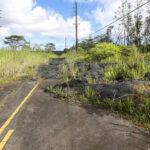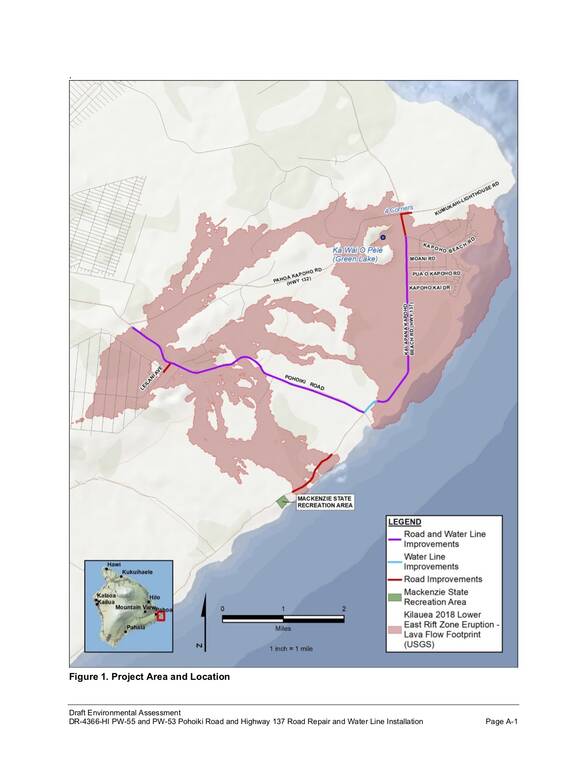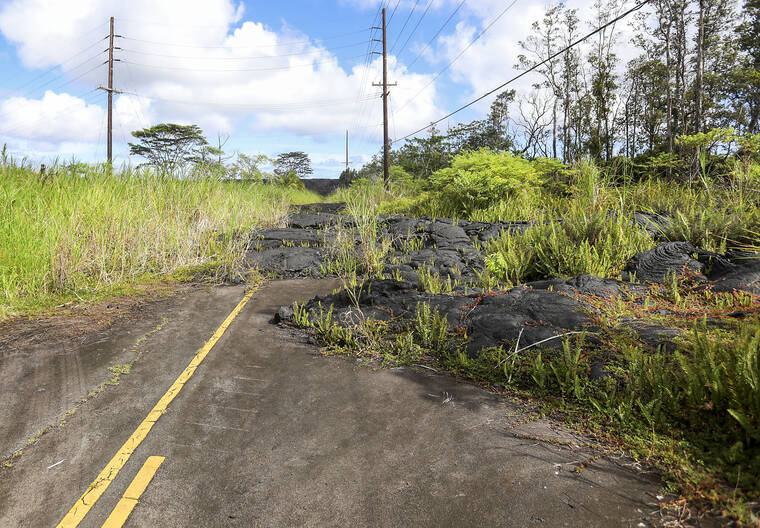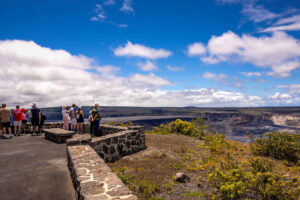Nearly five years after the end of the 2018 Kilauea eruption, a long-delayed environmental report about the reopening of Pohoiki Road and other lower Puna roads inundated by lava finally was published Thursday.
In 2018, lava from Kilauea’s lower East Rift Zone covered 13.7 square miles of land in Puna, inundating approximately 32.3 miles of roads and 14.5 miles of waterlines, according to Hawaii County data. Since then, the county has pursued projects to clear and reopen many of those roads.
But a project that would reopen Pohoiki Road, Highway 137 and Lighthouse Road has been repeatedly delayed as the county awaited the completion of a draft environmental assessment by the Federal Emergency Management Agency.
With FEMA is contributing 75% of the project’s cost — a $61.5 million grant for road reopening plus another $30 million grant for water infrastructure, with the county picking up the remaining 25% — the agency required that an EA be completed before the funds could be awarded. However, estimates for when a draft of that assessment would be completed have been repeatedly pushed back throughout this year.
“We wanted to get this done sooner, and it’s been frustrating, and we empathize with the community’s frustration,” said county Recovery Officer Doug Le, who said FEMA required additional time and human resources to complete the assessment.
Now that the draft EA is completed, Le said the remainder of the project will stay, by and large, in the county’s control, although he added that “FEMA doesn’t just disappear,” and the agency will be monitoring the progress.
According to the draft assessment, the project will rebuild about 9.1 miles of roads and install about 7.8 miles of waterlines throughout lower Puna over the course of four phases.
Phase 1 would reconstruct 60 feet of Kumukahi-Lighthouse Road east of Highway 137 and a stretch of Highway 137 from the “Four Corners” intersection to Kapoho Beach Road, which would take approximately nine months.
Three months after the start of the first phase, Phase 2 will rebuild and install waterlines along Pohoiki Road, which would take 18 months to complete.
The work on Pohoiki also will shift the road southward by 50 feet to 200 feet to minimize impacts to mango trees along the side of the road.
About three months after Phase 2 begins, Phase 3 would rebuild a stretch of Highway 137 connecting the work from Phase 1 to Pohoiki Road, and installing waterlines, over the course of 12 months.
Once the first three phases are complete, Phase 4, which will rebuild Highway 137 across another lobe of lava near MacKenzie State Recreation Area, will begin. This last phase is anticipated to take seven months.
All told, the full project is anticipated to take 32 months to complete, including the finalization of the project design, which Le said cannot be finished until the approval of the final environmental assessment in September. Le added that selecting a contractor for the project also is a next step for the project after the final EA is published.
Construction could begin early next year, Le said.
With the FEMA hurdle finally passed, some Puna residents cut off from their properties can once again look forward to eventually being able to return to their homes, although more recovery work will be necessary.
“Even when we’re back, we still don’t have a community evacuation plan,” said former Puna Councilwoman Eileen O’Hara, executive director of nonprofit Malama O Puna. “We don’t even really know who’s still living out there.”
“I had hoped we would see a road two years back or more,” said Deb Smith, whose Kapoho home was destroyed in the eruption and is currently living in an adjacent lot isolated by lava. “We’re still hiking across lava in and out. … I’m landing (Friday), I’m going to be picked up at the airport, and I’ll have to hike two miles across lava in the dark.
“It’s just time,” Smith said with a weary sigh.
O’Hara said the entire process has been “maddening” for the community, adding that she feels it has been fumbled at nearly every stage. She drew comparisons to California communities that have been ravaged by wildfires in recent years.
“In California, you get towns that have been able to entirely rebuild in just a few years,” O’Hara said. “But here, we can’t even reopen a few miles of roads. And we’re still struggling. There’s been no economic burst here, Pahoa’s dismal. … People here are very dejected.”
The public can read the draft EA here: https://tinyurl.com/4962ch3r. A 30-day comment period regarding the report ends Sept. 5.
The county also will host a virtual public meeting about the draft EA from 5 p.m. to 6:30 p.m. on Aug. 8 via Zoom. Visit https://recovery.hawaiicounty.gov/infrastructure for details.
Email Michael Brestovansky at mbrestovansky@hawaiitribune-herald.com.









